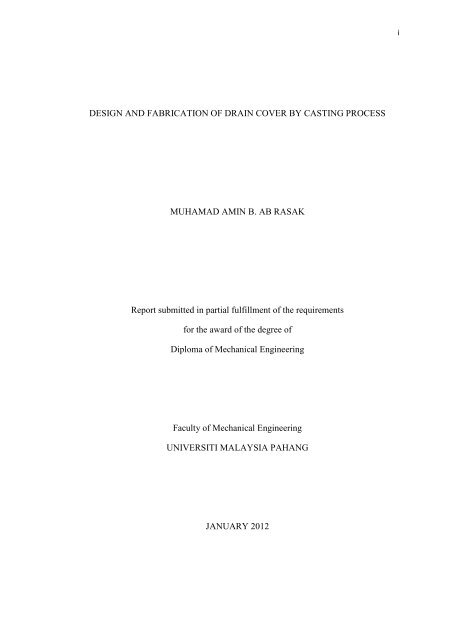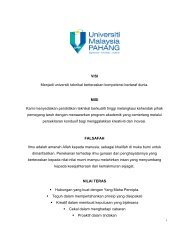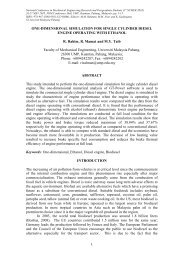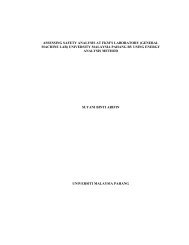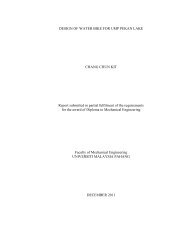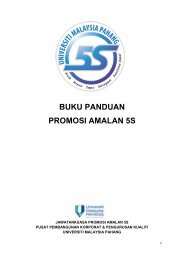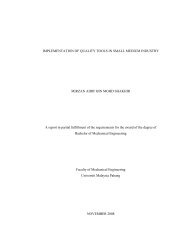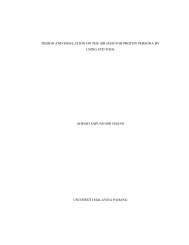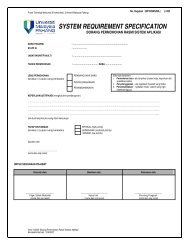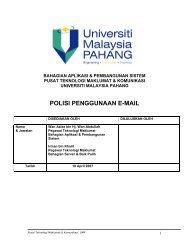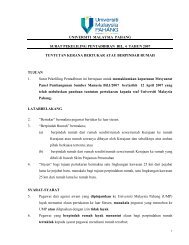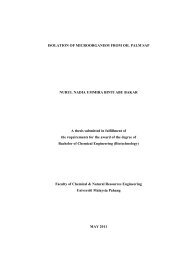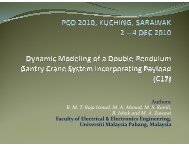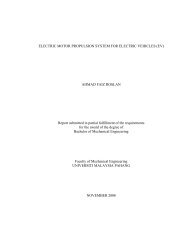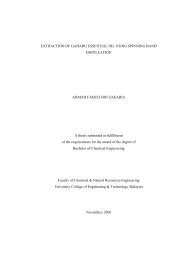DESIGN AND FABRICATION OF DRAIN COVER BY CASTING ...
DESIGN AND FABRICATION OF DRAIN COVER BY CASTING ...
DESIGN AND FABRICATION OF DRAIN COVER BY CASTING ...
You also want an ePaper? Increase the reach of your titles
YUMPU automatically turns print PDFs into web optimized ePapers that Google loves.
viiTABLE <strong>OF</strong> CONTENTSCHAPTER TITLE PAGESUPERVISOR’S DECLARATIONDEDICATIONSTUDENT ‘S DECLARATIONACKNOWLEDGMENTABSTRACTTABLE <strong>OF</strong> CONTENTiiiiiivvvivii1 INTRODUCTION1.1 Background 11.2 Problem Statement 21.3 Objective 21.4 Scope 21.5 Process Flowchart 31.6 Gantt Chart 4
viii2 LITERATURE REVIEW2.1 Introduction 52.2 Type Of Drain Cover 52.3 Technical Review 73 METHODOLOGY3.1 Project Methodology 103.2 Preliminary Design 103.3 Sketching 113.3.1 Preliminary Concept design 123.3.2 Concept Screening Method 123.3.3 Concept Scorring Method 133.4 Finalize Concept 143.5 Material Selection 153.5.1 Material Selection Criteria 153.6 Pattern Making 163.7 Fabrication Process 174 RESULT <strong>AND</strong> DISCUSSION4.1 Introduction 234.2 Result 234.3 Solution Method 244.4 Problem Faced 25
1CHAPTER 1Introduction1.6 BackgroundLong ago, drain cover was made just as simple as possible as their function is only tocover up drain. Drain cover usually was made up from reinforced concrete, steel orplastic with just very simple design. As world became modern, people make morecomplicated drain cover with various types of shape and design. These products are usedfor industry or domestic purpose. Since its function is just not only to cover up the drainitself but it also maybe need to be lightweight, anti-rust, strong, or good looking. Somedrain cover was made to be lightweight as to easy people to lift the cover for anypurpose. While some drain cover was made to be very strong as its functions are to standhigh load on it without breaking or bending. Design of drain cover nowadays is not onlyto cover up the drain itself but must according to what is the characteristic of the draincover need to have. Drain covers are produces in various ways such as casting process,injection molding, welding and many more.Drain cover are fabricated according to its design and characteristics. Some arefabricated by using welding method while other methods used are casting or injectionmolding. Welding method is usually use to fabricate simple design of drain cover andcheap cost production as this method is very simple and does not use any high advanceequipment. However these methods usually produce low finishing and do not longlasting.
31.5 Process FlowchartFigure 1.1 shows the process flow of how this project is done. This makes usefultools how processes work is done throughout the project.StartTitle, Objective and ScopeConfirmationsResearch and Further ReadingLiterature ReviewDesign ConceptChoose ConceptSolidWork/CADFabricationProject PresentationReport PreparationEnd
41.6 Grant chartFigure 1.2 shows the progress of the project.
5CHAPTER 2Literature Review2.1 IntroductionDrain cover is to cover drain from expose to danger and to give support for waythrough. We already knew that many design and size we can found at market. There arevarious type of drain cover in market. This literature review will show some type inmarket and their characteristics. This literature review also show about the process that Ihave applied while builds my drain cover.2.2 Type of Drain Coveri. Normal Typeii. U-Typeiii. Security Type (anti-theft)
6Normal types of drain cover are a major type that we can see in everywhere. These typesof drain cover are shows on figure 2.1 which is embedded installation, safe and reliable,anti-thrust (not easy to shed).Figure 2.1: Normal TypeFigure 2.2 shows U-Type Drain Cover which adopt angle steel as the end plate, whenconstruct, it does need to bury in advance. Besides that, The U-type drain cover has thecharacteristics such as large area for water leakage, easy and convenient to install, highsafety.Figure 2.2: U-Type
7Figure 2.3 shows Security Type (anti-theft). Both ends connected with steel framethrough gemel, so anti theft and safe. This type of drain cover usually used for largedrain which also dangerous place.Figure 2.3: Security Type2.3 Technical ReviewTechnical review shows the available drain cover products in market and itsspecification.Figure 2.4
8Table below shows quick details of drain cover in figure 2.4Type: DrainsStyle: Push Down Pop-Up Material: Recycle PPModel Number: FDR 350 Application: Floor Material: PlasticProduct Measurement: 445 x 216 x 35mmFigure 2.5Table below shows quick details of drain cover in figure 2.5Type: Drains Material: Plastic Brand Name: FeltonModel Number: FDR 300 Application: Floor Surface Treatment: PolishedStyle: Push Down Pop-UpMaterial: Recycle PPProduct Measurement: 380 x 152 x 35mm
9Figure 2.6Table below shows quick details of drain cover in figure 2.6Material: SteelBrand Name: LIHONGSteel material : ASTM A36 or Q235 Place of Origin: Zhejiang, ChinaSurface : Hot dip Galvanized or Self color CERTIFICATE : ISO9001-2000Drain system : trench grate, drain cover Place of Origin: Zhejiang China (Mainland)
10CHAPTER 3Methodology3.1 Project MethodologyThis chapter consists a review of the current design and other information about thecurrent design. These tasks have been done through research on the internet, books andother sources.3.2 Preliminary DesignAfter gathering all the relevant information, the project undergoes design inSolidWork. In this step, the information gathered from the review is used to make adesign. Before starting to the SolidWork design, the idea firstly is sketched in a piece ofpaper. All the idea generated is sketched and then is analyzed before moving toSolidWork design. The design is analyzed based on its suitability to be fabricated bysand casting process. After choosing the best design, the design then undergoes materialselection process. Then the sketch then is turned into SolidWork design. In this step, thedesign is drawn into 2D and 3D and put into dimension.
113.3 SketchingDesign ADesign BDesign CDesign D
123.3.1 Preliminary Concept DesignTable 3.1: Preliminary concept evaluationCriteria Concept A Concept B Concept C Concept DLightweight NO YES NO YESAnti-rusting NO YES NO YESStrong YES NO YES YESGood looking YES YES NO YES3.3.2 Concept Screening MethodsTable 3.2: Concept Screening MethodsConcepts variantsSelectioncriteria A B C REF.Lightweight 0 0 _ 0Anti-rusting + 0 0 0Strong + 0 + 0Good looking _ + 0 0Ease of production + 0 0 0Pluses 3 1 1Sames 2 5 4Minuses 1 0 1Net 2 1 0Rank 1 2 3Continue? Yes Yes No
3.2.3 Concept Scorrning Methods13
3.4 Finalize concept14
153.5 Material Selection3.5.1 Material Selection Criteriai. Easy for machiningIn this project, the drain cover will be trimmed by cutting machine. The materialmust be ductile and soft or easy to machining by any cutting machine.ii.Anti rustingThe material must be anti-corrosion.iii.StrongThe material must able to stand high load without breaking or bending.iv.Low melting pointThe material need to have low melting point to easy the melting process in thefurnace.v. WeightThe material must be lightweight.vi.CostThe material cost must not be too expensive and affordable to everyone. Thequality must balance with the cost.
163.6 Pattern MakingTo proceed for the fabrication process, the pattern of the drain covers must be madefirst. There are different ways on how to makes the pattern. Material used to make thepattern may be different according to the product. However in this process plywood areused to make as the drain cover pattern. The steps of pattern making are shown asbelow:-i. Measuring and marking processii. Cutting processiii. Shapingiv. Tapering/ChamferingFigure 3.1: Drain cover patternFigure 3.1 shows the top view of the drain cover pattern.
17Figure 3.2: Drain cover patternFigure 3.2 shows the bottom view of the drain cover pattern.3.7 Fabrication ProcessIn this process, the drain cover is fabricated by using sand casting process. Thismethod is chosen because of its ability to form complex metal geometries and can bemade of nearly any alloy. However this method typically has a low production rate. Thisis because; the sand mould must be destroyed in order to get the casting part.The casting process involves the use of furnace, cast iron, drain cover pattern andsand mold. The cast iron is melted in the furnace and then is poured into the cavity of thesand mold which is from by the drain cover pattern. The sand casting process consists ofsix main stages which is mold making, clamping, pouring, cooling, removal andtrimming.
18i. Mold makingFirst step in sand casting process is to create the mold for the casting process. A sandmold is formed by packing sand into each half of the mold. The sand is tightlypacked around the pattern. The pattern is then removed and the cavity leaves theshape of the pattern. The lubricant is then also applied onto the surface of moldcavity in order to facilitate removal of the casting. Besides, the lubricants alsoimprove the flow ability of the molten cast iron into the cavity and improve thesurface finish of the casting. The lubricant use is chosen based on the sand andmolten cast iron temperature.Figure 3.4: Mold
19Figure 3.3: Pattern in a moldFigure 3.5: Mold cavity with pattern shape
20ii.Clamping ProcessThe molten cast iron is prepared for pouring process after the mold has been made`.The cores then are positioned in the hole section and the mold halves are closed andtightly clamp together. The mold halves are checked to remain securely closed toprevent any material waste.Figure 3.6: Clamping processFigure 3.7: Pouring process
21iii.Pouring ProcessA piece or block of cast iron is heated until melted in a furnace and maintained at aset of temperature. Then the molten cast iron is ladled from it holding container inthe furnace and then poured into the cavity of the mold. The molten cast iron must beenough to fill the entire cavity and all channels in the mold. The pouring of moltenaluminum is doing faster enough to prevent from early solidification of any parts ofthe metal.iv.Cooling ProcessThe molten metal that is poured into the mold cavity is leaves to cool and solidify.When the entire cavity is filled and the molten cast iron solidifies the final shape ofdrain cover is formed. The mold however cannot be opened until the cooling timehas elapsed.v. Removal ProcessAfter the predetermine solidification time has passed, the mold is opened and thesand mold is removed. This step uses vibration machine or anything that shakes thesand.
22Figure 3.8: Removal processvi.Trimming ProcessDuring cooling the material from the channels in the mold solidifies attached to thepart. In this process, the excessive part must be trimmed from the casting manuallyusing cutting machine.
23CHAPTER 4Result and Discussion4.1 IntroductionThis chapter will present the solution method used to solved the problem statementand show all the design drawing by SolidWork with the actual product and shows theproblem faced during the casting process.4.2 ResultFigure 4.1: Drain Cover
24Figure 3.4 shows top view of the actual product of drain cover by castingprocess before trimming.Figure 4.2: Drain coverFigure 3.5 shows bottom view of the actual product of drain cover bycasting process before trimming.4.3 Solution Methodcover.To solve the problem statement, the following steps are taken and apply to the draini. Rusting- Spray protective layer to prevent from rustingii. Bad design- Sketch few design and select the best design by screening and scoringconcept.


